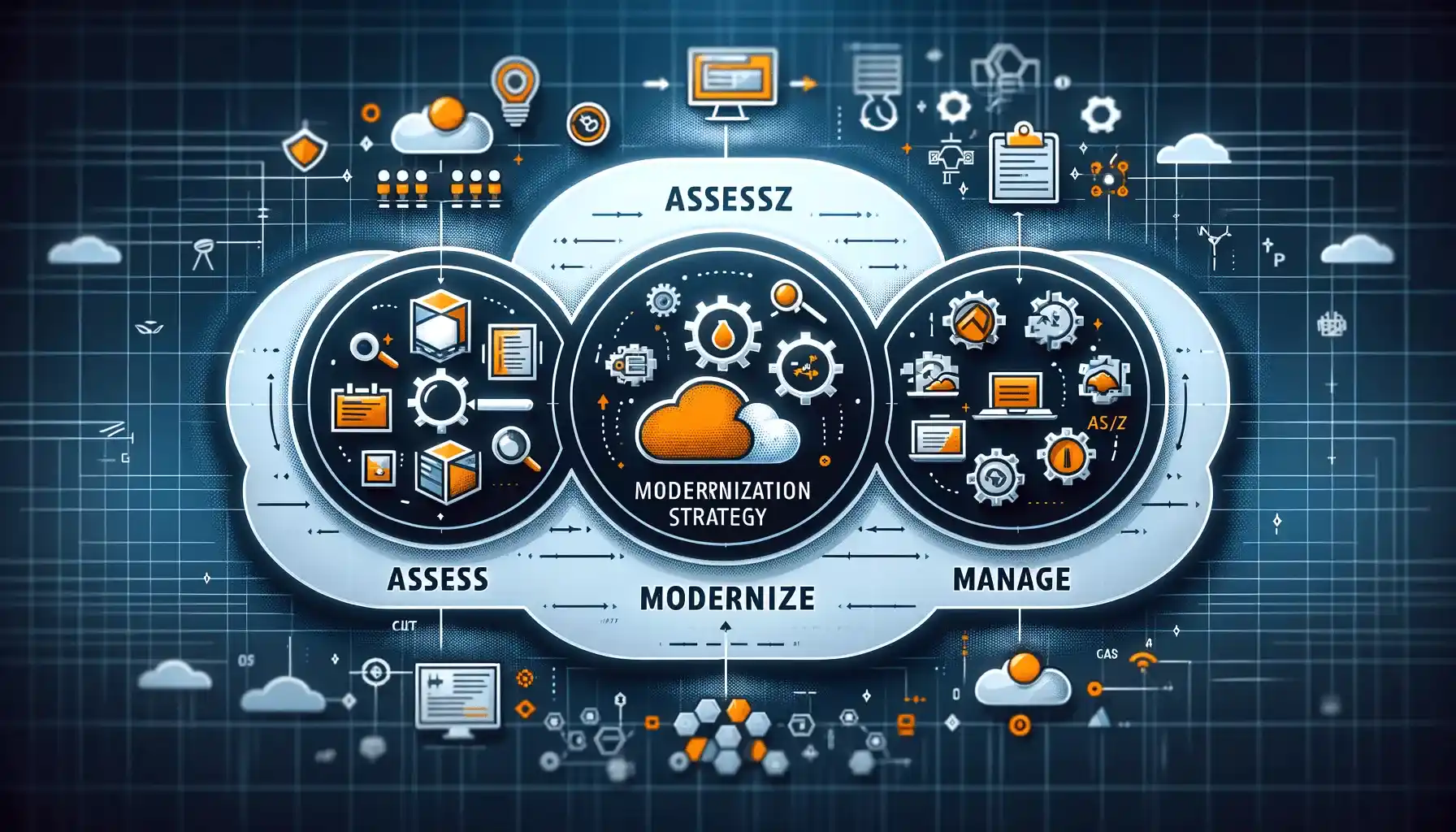Table of Contents
In today’s digital era, the migration to cloud-based solutions has become imperative for businesses seeking enhanced agility, scalability, and cost-efficiency. At the forefront of this transition stands Amazon Web Services (AWS), offering a comprehensive suite of tools and services to facilitate application modernization.
By leveraging AWS, organizations can streamline their operations, reduce downtime, and unlock new avenues for innovation and growth.

What is AWS Application Modernization?
AWS (Amazon Web Services) Application Modernization refers to the process of updating and optimizing applications to leverage the full potential of cloud-native architectures and services offered by AWS.
In essence, AWS Application Modernization goes beyond simple migration to the cloud. It involves rearchitecting and refactoring applications to take advantage of modern cloud computing paradigms, such as microservices, containers, serverless computing, and managed services.
This modernization approach aims to enhance scalability, performance, security, and cost-effectiveness, allowing organizations to innovate faster, improve agility, and deliver better user experiences.
By leveraging AWS’s comprehensive suite of tools, services, and expertise, businesses can transform their legacy applications into modern, cloud-native solutions that are optimized for the digital age
Why AWS Application Modernization?
AWS Application Modernization offers numerous compelling reasons for businesses to embrace it. One of the primary draws is the substantial cost reductions it can bring. By migrating and modernizing applications on AWS, organizations can reduce their total cost of ownership by up to 64%, alongside cutting downtime by 40%. These savings stem from AWS’s efficient infrastructure, pay-as-you-go pricing model, and elimination of upfront capital investment.
Moreover, AWS enables increased operational efficiency, allowing businesses to streamline processes, improve resource utilization, and scale dynamically as needed. This combination of cost reduction and operational optimization makes AWS App Modernization an attractive proposition for organizations looking to stay competitive in the digital age.
Components of AWS Application Modernization Strategy
The modernization journey on AWS typically unfolds in three distinct phases: assess, modernize, and manage. Each phase plays a crucial role in enabling organizations to harness the full potential of AWS and drive meaningful transformation.
- Assess: The assessment phase involves thoroughly analyzing the existing application portfolio to identify candidates for AWS Application modernization. By evaluating factors such as business fit, technical suitability, and financial capabilities, organizations can prioritize their modernization efforts and develop a targeted roadmap for implementation.
- Modernize: Once the assessment is complete, organizations can proceed to the modernization phase, focusing on revitalizing their applications using cloud-native architectures and best practices. This phase involves defining project milestones, adopting agile methodologies, and leveraging automated processes to streamline migration and ensure successful outcomes.
- Manage The final phase of AWS application modernization centers on continuous learning and optimization. Organizations must gain a detailed understanding of their modernized workloads, emphasize a DevOps culture, and integrate operational features seamlessly into engineering workflows. By prioritizing change management and quality assurance, organizations can lay the foundation for sustained modernization success.

Best Practices for AWS Application Modernization
- Assess Current Application Portfolio: Before embarking on the AWS Application modernization journey, it’s essential to conduct a comprehensive assessment of your current application portfolio. Identify legacy applications that are prime candidates for modernization based on factors such as complexity, criticality, and business value. This assessment will help prioritize modernization efforts and allocate resources effectively. Real-World Instance: Netflix migrated its legacy monolithic architecture to AWS, prioritizing critical components and leveraging cloud-native services like AWS Lambda and Amazon DynamoDB. This approach enabled Netflix to achieve greater scalability and flexibility while reducing infrastructure costs.
- Adopt Cloud-Native Architectures: Embrace cloud-native architectures such as microservices, serverless computing, and containerization to modernize your applications on AWS effectively. These architectures offer benefits such as improved scalability, resilience, and resource utilization, enabling organizations to deliver more agile and innovative solutions. Real-World Instance: Airbnb modernized its infrastructure on AWS Application modernization using microservices architecture, allowing it to scale rapidly to meet fluctuating demand while maintaining high availability and performance. This transformation enabled Airbnb to innovate faster and deliver new features to users more efficiently.
- Leverage Managed Services: Take advantage of AWS-managed services such as Amazon RDS, Amazon Aurora, and AWS Lambda to offload infrastructure management tasks and focus on application development and innovation. These managed services provide built-in scalability, reliability, and security, allowing organizations to accelerate their modernization efforts. Real-World Instance: Capital One modernized its banking systems on AWS using managed services like Amazon RDS and AWS Lambda. By leveraging these services, Capital One reduced operational overhead and achieved greater agility in delivering new banking features and services to customers.
- Automate Deployment and Testing: Implement continuous integration and continuous deployment (CI/CD) pipelines using AWS services like AWS CodePipeline, AWS CodeBuild, and AWS CodeDeploy to automate the deployment and testing of your applications. This automation streamlines the release process, reduces manual errors, and improves overall software quality. Real-World Sample: Intuit modernized its tax preparation software on AWS using CI/CD pipelines, enabling it to release updates and bug fixes more frequently and reliably. This approach allowed Intuit to deliver a better user experience and respond quickly to changing customer needs.
- Ensure Security and Compliance: Prioritize security and compliance throughout the modernization process by implementing AWS security best practices and compliance standards such as HIPAA, GDPR, and PCI DSS. Leverage AWS services like AWS Identity and Access Management (IAM), AWS Key Management Service (KMS), and AWS Config to secure your applications and data in the cloud. Real-World Specimen: Pfizer modernized its drug discovery platform on AWS while maintaining compliance with regulatory requirements such as HIPAA and GDPR. By implementing robust security controls and encryption mechanisms, Pfizer ensured the confidentiality and integrity of sensitive patient data.
Tools for AWS Application Modernization
- AWS Server Migration Service (SMS): AWS SMS enables organizations to automate the migration of on-premises applications to AWS, making it easier to modernize legacy infrastructure and applications. With AWS SMS, you can automate the discovery, replication, and cutover of servers, minimizing downtime and disruption during the migration process.
- AWS Database Migration Service (DMS): AWS DMS allows organizations to migrate databases to AWS quickly and securely, enabling seamless data modernization. With AWS DMS, you can migrate databases to AWS with minimal downtime, perform heterogeneous database migrations, and continuously replicate data to AWS for disaster recovery and high availability.
- AWS App Runner: AWS App Runner is a fully managed container service that makes it easy to deploy, manage, and scale containerized applications on AWS. With AWS App Runner, you can quickly deploy applications from source code or container images, automatically scale resources based on demand, and monitor application performance in real-time.
- AWS Lambda: AWS Lambda is a serverless computing service that enables organizations to run code without provisioning or managing servers. With AWS Lambda, you can execute code in response to events, such as HTTP requests, database changes, or file uploads, enabling serverless application development and event

Conclusion
AWS application modernization represents a transformative journey towards enhanced efficiency, scalability, and innovation. By leveraging AWS’s robust ecosystem of tools and services, organizations can modernize their applications, streamline their operations, and unlock new growth opportunities.
With the right strategies and tools in place, organizations can embark on their modernization journey with confidence, knowing that they have the support and expertise needed to succeed in today’s digital landscape.